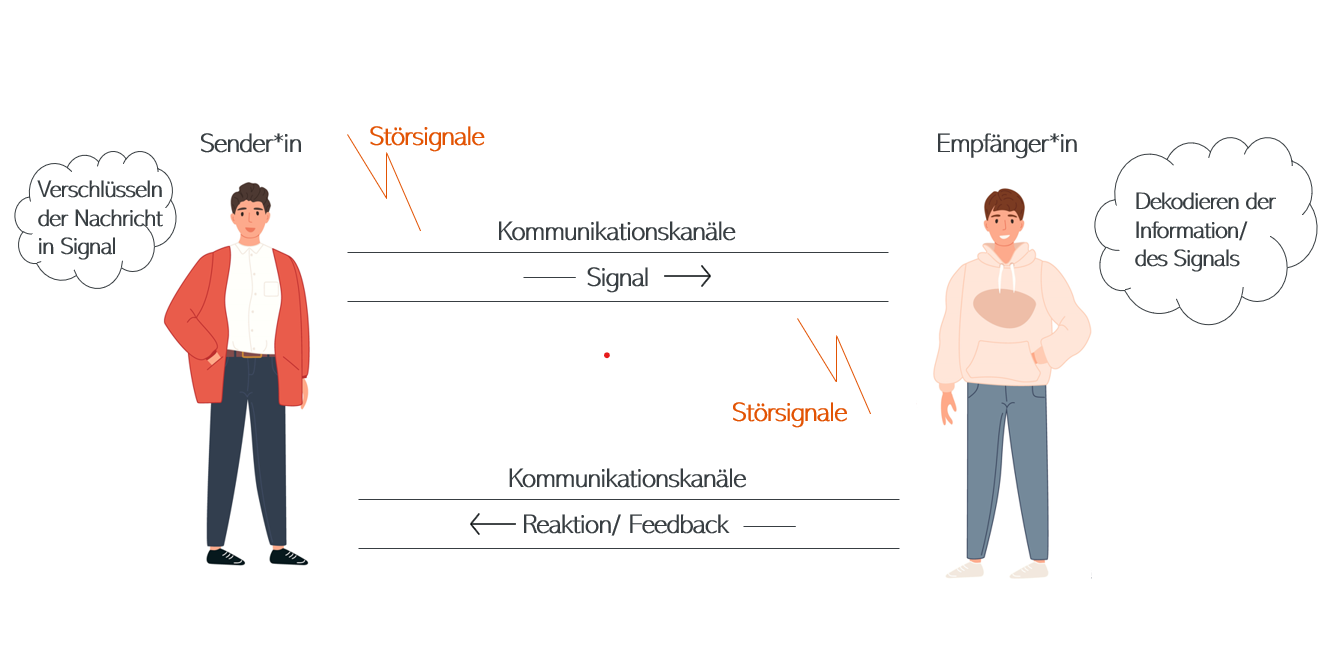You spend about 70,000 hours of your life in your workplace. That is 2,917 days. In almost all professions, you come into contact with other people almost every day. We interact and communicate - And a lot can go wrong. Who does not know the one colleague who always sees the negative or the other who we simply don't understand what she wants from us.
So communication is a Important key factor For a functioning work environment. The good news is that suitable communication can be learned, which is why it is worth taking a closer look at it. In our today's Mr Beam Blog post we give you helpful tips for one appreciative communication in the workplace.
What is communication?
Always where people work together, communication is used as a means of interaction. But what exactly is meant: The word communication comes from the Latin “Communicatio”what communication means. Communication is therefore the transmission or exchange of information between at least 2 people.
There are different models that draw our attention to different processes and components of communication.
The transmitter recipient model
There are 2 players in this model. On the one hand, the transmitter that formulates a message in the form of a signal, e.g. a sentence and sends it to the recipient via the communication channel. The channels include all sensory levels, such as acoustics, optical and tactile. The recipient interprets the signal, whereby the interpretation is influenced by aspects such as the underlying background knowledge, own experiences and intentions of the recipient. Disturbance signals can influence and modify the transmission of the messages.

The iceberg model
That Ice mountain model shows the different levels of every communication. There is a factual and a relationship level. The former includes numbers, data and facts. We are aware of it. Second people include your unconscious feelings, needs, instincts and experiences. This part is considerably larger and lies, so to speak, below the water surface.
The four-ear model
A third and last model that is to be addressed here refers to the 4 pages of a message between the transmitter and recipient, the four-ear model:
- Subject: Includes the facts.
- Self -open: What does the message say about the recipient? "What Lena says about Lisa tells us more about Lena than about Lisa. ''
- Relationship level: How do the transmitters and recipients relate to each other?
- Appeal: What should the recipient do with the message, how should he react?
The recipient can now decide which of these 4 pages he reacts.
What is the difference between verbal and non -verbal communication?

Now you have seen how comprehensive communication is and can perhaps better understand why communication is not always clear or simple.
But communication can Not just verbally, that is, through language, but also non -verbal. Counts to non -verbal communication:
- facial expressions
- gesture
- Tones
- Movements/ kinesthetics
- Distress
- Body language
- posture
- Sound & modulation of the voice
For example, non -verbal communication is used to convey implicit messages or underline verbal statements.
Example: In a hierarchical group structure, the boss is allowed to let you wait, but the other way around you should not appear too late for a meeting. That is the implicit demonstration of the status difference.
Why is communication important in the workplace?
Communication has great power and shapes our reality.
We consciously perceive only 2 % of communication. Often we automatically take a usual perspective and value what I have said instead of only taking it neutral. Our brain can also absorb things more easily that match previous experiences. Facts are therefore more accepted if they fit our world view. If we enter this point and train consciously, this can lead to more efficient interactions. That can in turn Promote the performance of employees as well as improve the emotional condition. Work commitment can also be increased through good management communication.
Another example of the importance of interpersonal interaction in the workplace is the phenomenon known as a social facilitation. It says that the physical presence of others alone can increase performance in the acting of usual activities, so it causes physiological activation in our brain.
How do I improve communication in the workplace?
As already mentioned above, communication consists of many different facets and every person also brings different properties and behaviors into an interaction. This can lead to unpleasant situations or potential for conflict.
So how can you counteract this?
The key is one appreciative communication. Appreciative means that you recognize something, give something a value and it respect treated. This implies that appreciative communication does not only take place on the factual level mentioned above, but above all the Relationship level, With Feelings and needs, including. Every professional discussion is based on emotional sensations and needs, such as the desire for respect, appreciation or autonomy. Including this in the workplace can be a big gamuchanger. It may seem strange at the beginning to talk about feelings in a mostly very factual work environment, but it depends on how to do it. Learning and using empathy is very helpful. The ability to feel into others makes a significant contribution to solving interpersonal differences.
A widespread tool to introduce appreciative communication at work is non -violent communication (GFK) by Marshall B. Rosenberg.

In the GFK, the wolf represents the destructive type of communication, which occurs under high stress and pressure. The giraffe stands for appreciative communication.
In the following you will find other useful tips on how to work on your appreciative communication.
How can appreciative communication improve working atmosphere?
“If we want to create a climate of trust, we have to start with ourselves. For this we cannot avoid changing our own behavior.” - Ebert & Pastoors
Many represent the assumption that we have to use the elbows in our competition and performance society to be successful. But there is another way. Through appreciative communication You not only improve your work, but also create a more pleasant atmosphere.
The following points of appreciative communication contribute to a harmonious working atmosphere:
- Optimism: Think optimistic. Without pressure, it is easier to persuade people to work effective. Also try to avoid no and non-statements if not necessary. These have a demotivating effect in the form that is too frequent.
- A respectful approach: Every person feels more valued, it also promotes identification with the company, the joy of work and the appearance of the company to the outside: employees who are taken seriously also take customers seriously.
- Serenity: Attempts in stressful situations to focus on factual facts and to solve you from emotional triggers.
- Long -term nature: Avoid small chess trains that bring short -term advantages but affect the relationship and trust in colleagues in the long term.
Attention: Communication has 2 sides, talking and listening. Try to always make a balance here. Be with the head in the here and now. Go to what has been said, repeat it in their own words or react non -verbally, e.g. with a nod.

What do managers have to consider when appreciative communication with employees?
"A leader Falls Short of Greatness Without Great Skill in Face-to-Face Talk." - David Kantor
The most important influence on the behavior of employees is leadership. A good manager is characterized Not only through special expertise in their field, but also through the ability to guide a team. This includes tasks such as: informing, promoting employees, creating good climate and trust. Estimating communication accounts for most of the management work and cannot be separated from it.
Appreciative communication in the leadership:
- Model function: Try as Pretend a good role model and example and be a source of inspiration for others. This function is very important, because the behavior of superiors color not only on the habits of the employees, but also on their mental constitution.
- The right leadership style: There are different ways to lead a team. You can read which styles there are and which best fit in our next blog post.
- A good feedback culture: Both praise and criticism are part of the feedback. After praise, no “but” should be given. It is also important not to criticize the person itself, but specific behaviors. Choose the right time for the feedback, a quiet place and thank you at the end of the conversation.
- 3 forms of communication: Depending on the individual and the topic, you can choose a different form of communication: verbally, in writing or non -verbal.
Infographic: DOS & DON’TS of employee communication with managers
How can poor communication be improved?
The first step and mostly the most challenging is the awareness of familiar communication patterns. If we have done this, we can break up unwanted behavior patterns in the next steps, practice new behaviors and thus consolidate them. You shouldn't be too strict with yourself Change habits takes time.
With these methods you can work on your appreciative communication:
Positive formulations
One method to modify, for example, generally negative attitude is positive reorganization. This means, for example, the change from DU- I formulations meant. Out of "You did that wrong." I will "like a different approach next time."
Another way to revert sentences is that Avoid generalizations and generalizations, so avoiding words like “always”, “never” or “every time”. More precise frequency information, such as “The last 2 times” or “I have noticed it 3 times”, are conceivable here. The criticism should relate to specific behavior and not to the entire nature of a person.
Positive framing
Framing, “frame” in German, says exactly what the word means. Depending on the framework we cover a situation or through which glasses we see something, we evaluate this. So is the glass half full (optimistic frame) or half empty (pessimistic frame)? A helpful tip is herethat first go out from the best case. For example, if you make an appointment with a colleague for coffee and this is already 15 minutes late, don't think: "He is so ruthless and just let me wait." A constructive way of thinking would be: "Oh, maybe a meeting came in between", an explanation will then certainly follow.
Mindfulness
Being mindful means perceiving things without evaluating them directly. Be patient with you, because to evaluate things is an automatic process. We have to learn again to break up our thinking process in the individual steps perception - break - rating. But what exactly does worthwhile perceive mean? Here's an example:
Judgmental: "I don't like the room layout in our office."
Perceptive: "The jobs in the office are arranged along the wall."

All of the above points and tips bring together appreciative communication at. The most important points for you are summarized below:
Summary Tips for appreciative communication
Did you like the article on appreciative communication? Then follow us Instagram, so as not to miss any further posts. We can also do our article "Tips for employee loyalty”Still recommend.
By the way, appreciative communication at the workplace is a matter of course for us. We always speak openly and at eye level. So we reach together at Mr Beam Our goals. If you also value appreciative communication, check our vacancies or apply to us initiative. We look forward to you! To the open spots.
Literature information:
Ebert, H. & Pastoors, S. (2018). Respekt. Springer Fachmedien Wiesbaden.
Einwiller, S., Sackmann, S. & Zerfaß, A. (2021). Handbuch Mitarbeiterkommunikation. Springer Fachmedien Wiesbaden.
Endrejat, P. C. & Meinecke, A. L. (2021). Kommunikation in Veränderungsprozessen. Springer Fachmedien Wiesbaden.
Nerdinger, F., Blickle, G. & Schaper, N. (2011). Arbeits- und Organisationspsychologie (2. Aufl.). Berlin/Heidelberg: Springer.
Schönberger, B. (2010). Gewaltfreie Kommunikation: der Schlüssel für eine effektive Konfliktlösung. Psychologie heute(1), 38–41.





